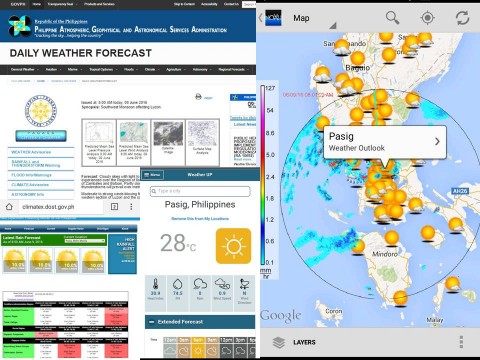Through the rain

OML Center Study Proposes a Regional Framework for Linking Adaptation, DRR and Loss and Damage at Dutch Conference
June 7, 2016
Oscar M. Lopez Center WEATHER ADVISORY, Low Pressure Area (Tropical Depression Ambo), 27 June 2016, 9:00 AM
June 27, 2016Ever regretted not heeding the advice to bring an umbrella? Don’t let the rains ruin your days. Instead prepare your rainy season “gear,” which should include websites and mobile applications that can get you through the rain. Here are some:
(1) DOST PAGASA http://www.pagasa.dost.gov.ph/
DOST PAGASA is THE weather authority in the country. They provide daily and extended (weekly to seasonal) weather forecasts. PAGASA’s Weather Advisories is a MUST visit webpage especially when there’s a Low Pressure Area (LPA) or Tropical Cyclone (Tropical Storm, Tropical Depression, Typhoon), or even just a heavy downpour (Check out how to make sense of the Heavy Rainfall Warning System from our previous advisory). Aside from these, they also provide Dam Water Level Updates, Flood Advisories, and Major river basin advisories.
Unknown to many, somewhere in PAGASA’s intricate web of a website is the http://meteopilipinas.gov.ph/ where you can access visualized information from the weather stations, doppler radar, satellite images and weather cameras.
You may also follow them on Facebook https://www.facebook.com/PAGASA.DOST.GOV.PH and Twitter https://twitter.com/dost_pagasa to keep updated on their advisories or download the PAGASA mobile app for android https://play.google.com/store/apps/details?id=ph.gov.dost.pagasa.gc.ccs
(2) Project NOAH http://noah.dost.gov.ph/
From the NOAH website and mobile app, you can access information such as chance of rain (4-hour weather forecast) and weather (7-day) outlook. You can also view images from satellites and Doppler stations.
The interesting features of Project NOAH (some of the many reasons it was created) are the real-time information from the rain gauges, weather stations, and tide levels; and flood hazard maps that serve as flood early warning system. Another key element is the Storm Surge Advisory.
And guess what? You can make these information available straight from your phone through the Project NOAH app!
Download links:
iOS https://itunes.apple.com/ph/app/dost-project-noah/id586126663?mt=8
Android https://play.google.com/store/apps/details?id=ph.gov.dost.noah.android&hl=en
Follow NOAH:
Twitter https://twitter.com/dost_projnoah
Facebook https://www.facebook.com/dostnoah/
Project NOAH [Nationwide Operational Assessment of Hazards] was launched by the DOST in response to President Aquino’s instruction to develop a program for disaster prevention and mitigation. It is a collaboration among national government agencies, including PAGASA.
(3) ClimateX http://climatex.dost.gov.ph/
ClimateX (also from DOST) is a fully automated rainfall prediction system based on information from Doppler Radars. It provides hourly forecasts with 1,2,3 and 4-hours lead times and gives estimates of real-time rainfall (updated every 15 minutes). Because it is fully automated, it has the capability to automatically send alerts through its AutoTweet function which provide updates on the chance of rain through its Twitter accounts:
ClimateX Philippines: https://twitter.com/climatexph
ClimateX Manila: https://twitter.com/climatex_manila
ClimateX Luzon: https://twitter.com/climatex_luz
ClimateX Visayas: https://twitter.com/climatex_vis
ClimateX Mindanao: https://twitter.com/climatex_min
The data from ClimateX is used in the following mobile apps: Project NOAH and ARKO.
(4) Weather Manila http://www.weather-manila.com/index.html
Weather Manila provides localized weather forecasts (3-hourly weather outlook for the next 5 days) in selected cities and municipalities in the country.
Weather Manila (with funding from the Oscar M. Lopez Center) created the Weather UP, a crowd-sourcing mobile weather app for the Philippines that allows the user to feedback their daily observations of the weather. This can help improve the next weather forecast as it helps verify the forecasts as observed by users in their respective locations.
Download links:
iOS https://itunes.apple.com/us/app/weather-up!/id971023394?ls=1&mt=8
Android https://play.google.com/store/apps/details?id=com.up_weather
Other useful websites/apps for flood advisories:
MMDA https://twitter.com/MMDA > Provides tweets on flooded streets / areas in Metro Manila
Interaksyon http://www.interaksyon.com/floodwatch > Provides news / updates on reported flooding in particular locations in the metro
Project NOAH Flood Patrol https://play.google.com/store/apps/details?id=xtend.noah&hl=en > Provides information on flood monitoring and mapping
So how can you maximize your use of these websites and apps? You can use PAGASA for your standard weather forecast, like knowing if a storm is coming and if your area will continue to experience a heavy downpour. If you want to know how much rain and flood this storm can cause in your area, you can check with NOAH. If you’re traveling within the Metro, make sure to check MMDA tweets for street-level information. If you need to know weather changes within the day, like if you should set up your party indoors or outdoors, ClimateX may come in handy. And if you want to inform friends of sudden weather changes on the spot, you can do this through the Weather UP.
Explore these websites and download the mobile apps that is most useful in your situation. They will come in handy this season.
Stay tuned for our next advisories that give you useful information on weather and climate!
You can be more resilient with a little help from technological innovations. So be prepared, be innovative. And choose resilience.
To check out our previous advisories, click here.
Investor: 1500 loan

